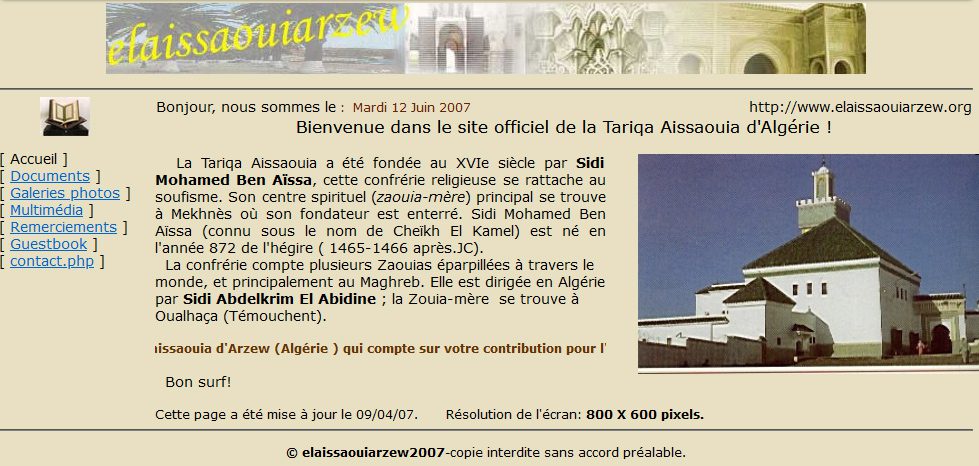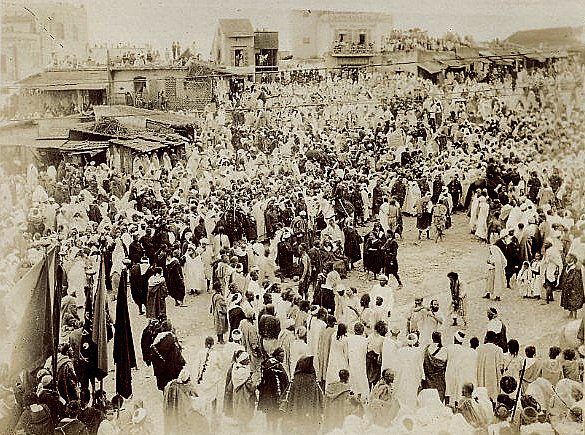Following the comment by Patrick, whose blog of memories of Morocco I recommend, Pas à pas se fait notre chemin, and after replying to him quickly, I’m looking for a bit more information on the Issawiyya, to back up my answer from memory.
The Issawiyya are probably less well known in outside of Morocco than the Gnawas, but in Morocco they are just as important. Like the Gnawas, they are a ‘nebula’ that can be approached from different angles.
A tribe from the south, between Tafraoute and Taroudant, they are at the origin of one of the most important brotherhoods in North Africa. Founded in the 16th century by Sidi Mohammed Ben Aïssa, its centre is in Meknes, where the saint is buried. It has branches throughout North Africa. The web page I mention at the end of the post was written by an Algerian who talks about the Issawiyya brotherhood in the town of Collo, near Skikda and Constantine.
The Issawiyya are a brotherhood, or zaouia
A whole site would be needed to talk about the Moroccan zawyias, and what they represent. Summing them up by saying that they are the local equivalent – mutatis mutandis – of the great abbeys of the Middle Ages, at once сеntrеѕ оf rеlіgіоn, study and hospitality for the poor, and stakeholders in politics, as a network of power and counter-power, gives a good idea.
A zаwіуа is organised around an Islamic saint, a Sidi, a pious man who loves God and to whom God gives the Baraka. Baraka is much more than ‘luck’, it is power, the power to perform miracles, to make a spring gush forth, to heal the sick, to expel the jinn, and more generally to protect one’s people. Baraka can be hereditary. The Sidi passes on his powers to his descendants, and little by little the Gnawas, the Issawiyya or others, thanks to this inherited power, become a tribe in their own right.
Most of the members of the brotherhood are members of the original tribe, but in the case of large brotherhoods, outsiders may also be welcomed. They will participate in the brotherhood, but will not have the same Baraka.
The zaouia is also the central building of the brotherhood, and at the same time the brotherhood itself. Just as the abbey is at once the building, thе оrgаnіѕаtіоn, its members and its culture. The building is built around the saint’s tomb (the marabout), which is the focus of all the baraka.
It generally includes an inn where pilgrims are welcomed, a mosque, a Koranic school with its library and a hospital. The zaouias provide a great deal of treatment for the mentally ill, thanks to their specific rites.
Sufism and zawiyas
Because zawiyas are steeped in Sufism. There’s a second subject on which we could do a whole site, and a third on the specific characteristics of Moroccan Sufism.
Sufism is the mystical and esoteric path of Islam. The believer seeks to dissolve his ego by constantly recalling God. This remembrance (dikhr) takes the form of long litanies, leading to trance, the repetition of God’s names, his praises and those of the saints. It can also be achieved through other rituals, such as dancing (like the dervishes), and trance, linked to the baraka, enables other rituals to be performed. Walk on fire, for example….
Sufism is a mystical, аѕсеtіс mоѵеmеnt. It is also feared by those in power for its power, and especially in southern Morocco, the zawiyas have been key players, pillars of organisation and resistance in the bled al siba (land of dissent) against the maghzen (the sometimes tiny part of Morocco effectively subject to the power of the sultans).
In a land of Islam, and therefore subject to God, any religious leader is a potential threat to political power…
Rituals, a spiritual path or “superstitions”
The rituals of the brotherhoods have also made room for pre-Islamic beliefs and practices. Magical rituals forbidden by Islam, and accepted because they become the manifestation of the power of God, through the baraka granted to the saint.
What remains of this spirituality varies from person to person.
Some will оnlу ѕее thе rіtuаl, the sheep or goat to be sacrificed, the power of the spell, for example the one that ties husbands to the gate of that other marabout in Marrakesh' medina.
Others will be especially sensitive to mysticism, to this quest to forget oneself in the divine. But very clearly, today, we will only talk openly about the second part, the rituals, the dikhr and the incantations.
Magic doesn’t exist, it’s done by others, no one knows about it, the neighbour perhaps… which makes you wonder what all those hands of Fatima and other protections against the evil eye are for?
Issawiyya, masters of fire and snakes
The Issawiyya are among the most feared in Morocco. I really like Patrick’s expression, “the whipping fathers”.
Their rituals are said to be terrible, including eating raw snakes. Most of the snake charmers you see in the souks and tourist spots are supposed to be Issawiyya… or at least employ them to capture their reptiles.

Their power is also great. Their zawiya in Meknes is allied to that of Moulay Idriss, the still forbidden holy city where the murdered founder of the first Moroccan dynasty is buried.
A tradition going online
These rites are not mentioned on their website. But there is a website, where the religious part of their ritual is well explained. As we often say in Morocco, “between tradition and modernity”! I advise you to visit this site, and in particular the MP3 file which gives a tiny extract from a litany. You close your eyes and imagine yourself in the dead of night, in a small, semi-darkened room, the drumbeats have been going on for a long time, and you join in this deep, steady chorus for hours on end….
And even the Tariqa Issawiyya had its own official website, from 2007 to 2020!

The Issawiyya are still on the web, but not directly
When I republished this post, I was pleasantly surprised to see that the site was still online, 15 years later!
This is rare in general, and even rarer for sites hosted on free.fr.
As I explored it, I realised that it was an Algerian site, well ahead of its time in terms of ‘modernity’, but that it was a chronicle, not the site of a brotherhood itself.
Nevertheless, there are photos of rituals and celebrations, which are quite rare.
I also found a site, probably a bit later, since it is based on a thesis defended in 2007 (and still on free.fr…) full of fascinating documents. You’ll find it in the information section of this post.
And finally, the official site of the Algerian Issawiyya, now only available on archive.org!
There are a lot of Issawiyya on the web, in fact!
When I was digging into the subject to prepare an “in-depth” post on the Issawiyya, I realised that there were dozens of small Issawiyya websites from that time onwards.
This was because Morocco wanted to support and promote this traditional culture. Many taifas (groups) presented and promoted their activity, which consisted of organising a night of prayers, trances and exorcism.
But at the time, this was not really indexed by Google.
 A typo or syntax error? You can select the text and hit Ctrl+Enter to send us a message. Thank you! If this post interested you, maybe you can also leave a comment. We'd love to exchange with you !
A typo or syntax error? You can select the text and hit Ctrl+Enter to send us a message. Thank you! If this post interested you, maybe you can also leave a comment. We'd love to exchange with you !


 Algeria
Algeria

